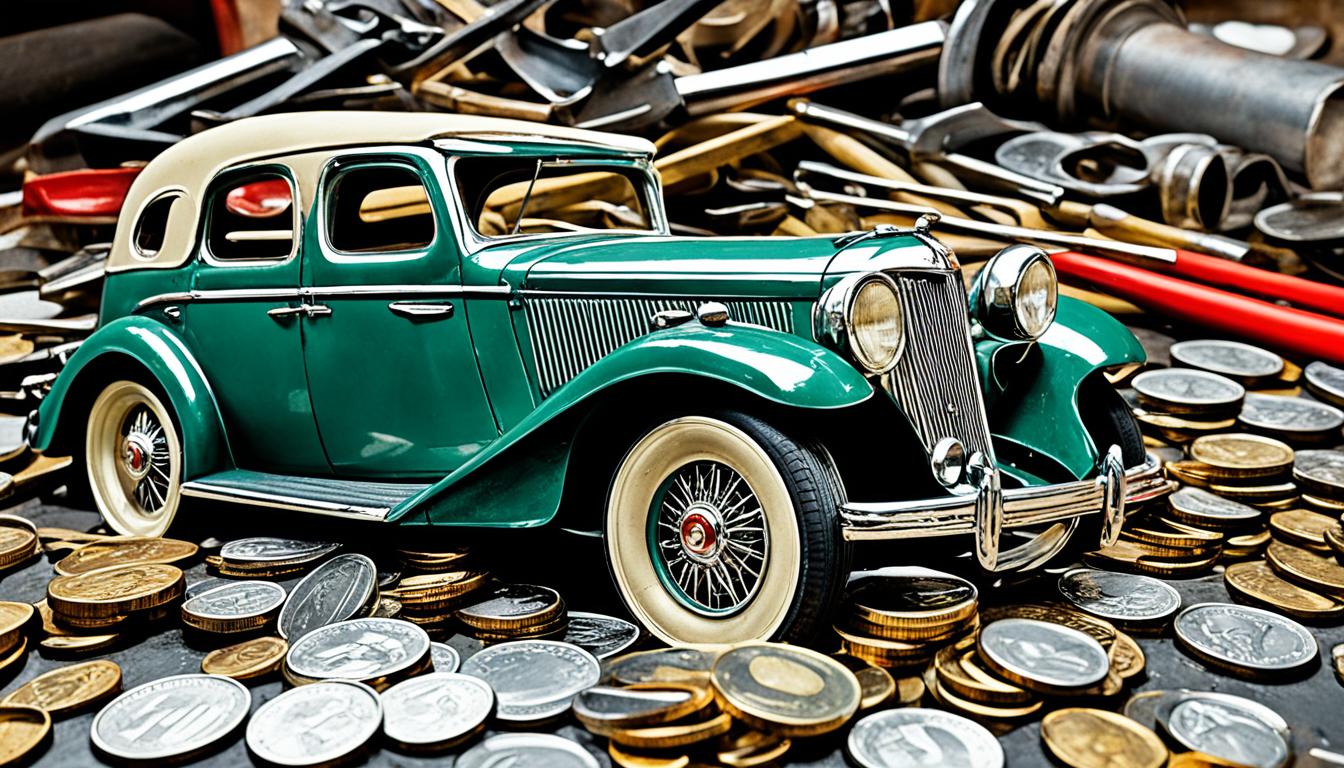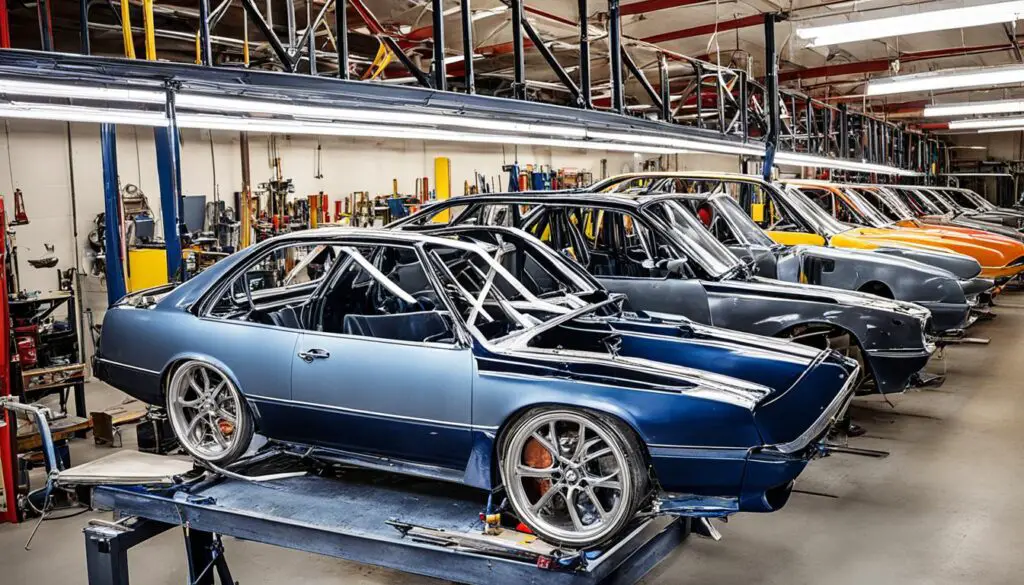
Budgeting Beauty: Car Frame Restoration Cost Guide
Car frame restoration is a true labor of love for fans of vintage cars. Planning and budgeting are key first steps. A complete restoration usually needs about 1,000 hours. This time is spent checking the car, making a plan, gathering tools, and doing the work.
Facing the true cost in time, money, and effort is important. This ensures your project will be a success.
Key Takeaways:
- Restoring a classic car requires careful budgeting and planning to account for the costs involved.
- A full restoration project can take up to 1,000 hours to complete, so be prepared for a significant time commitment.
- Assessing the condition of the car and creating a restoration plan are essential steps before starting the restoration process.
- Budget for expenses such as parts, labor, tools, and unexpected contingencies to avoid overspending during the restoration.
- Restoring a classic car is a rewarding journey that requires patience, skill, and a love for automotive history.
Assessing Your Classic Car
Before you start fixing up your classic car, it’s important to look it over carefully.
Check both the outside and inside for any signs of wear, rust, or damage. You also need to see how the engine, transmission, suspension, and electrical parts are doing.
This checking is key. It helps you know what you’ll be working towards and how much work is ahead.
It’s also good to look up what the car originally looked like. And think about how you want it to look in the end.
Doing this work sets you up well for the path to fixing up your classic car.
Planning and Budgeting
First, I checked my classic car’s condition. Then I made a detailed restoration plan and budget. This planning is key for a successful project.
Restoration Planning
I listed the tasks needed for each part of the car. I looked at the bodywork, the engine, and the inside. Breaking the work into small tasks kept me on track.
Next, I set a timeline with clear tasks and goals. This made it easy to see my progress. It helped me keep the project moving forward without missing important steps.
Budgeting for Car Restoration
Having a clear budget was as important as the plan. I figured out the costs, including parts, labor, and any extras. Knowing all the expenses helped me not overspend.
I researched to find out what similar projects cost. This helped me set a budget that was just right. It made sure I wouldn’t run out of money halfway through.
A good restoration plan and budget kept me focused and organized. It made everything clear. I knew what to expect and that I had enough money for a successful project.
Estimated Restoration Expenses
| Aspect of Restoration | Estimated Cost |
|---|---|
| Bodywork | $3,000 – $8,000 |
| Engine Restoration | $5,000 – $10,000 |
| Interior Refurbishment | $2,000 – $6,000 |
| Painting and Finishing | $3,000 – $7,000 |
| Additional Expenses (parts, labor, contingencies) | $5,000 – $10,000 |
| Total Estimated Cost | $18,000 – $41,000 |

The Restoration Process
The restoration journey gives new life to a classic car. It turns a forgotten find into a glorious ride. There are many steps in this journey, all vital for success.
1. Car Disassembly
First, the car is taken apart with great care. Every piece is removed, cataloged, and checked. This step helps see what needs fixing and makes the work easier later on.
2. Bodywork and Rust Restoration
Getting rid of rust and fixing dents is key. The bodywork phase fixes the car’s outer shell, making it look new. Rust repairs keep the car strong and stop more damage.
3. Engine Restoration
The car’s engine is its heartbeat. It’s fully cleaned and rebuilt to work like new. This part ensures the car runs as well as it looks.
4. Interior Refurbishment
The inside of the car also gets a full makeover. Everything from seats to trims is restored. This brings the car’s original charm and comfort back to life.
5. Painting and Finishing
The paint and final touches turn the car into a true beauty. A new coat of paint makes it shine. Polishing and plating add the final elegant touches.
6. Reassembly, Testing, and Tuning
Putting everything back is a precise task. Everything should fit and work perfectly. Testing ensures the car is as good as new.
7. Documenting the Journey
Taking pictures and notes through the process is special. These records show the effort and love put into the project. They are a history of the car’s rebirth.
Restoring a car takes a lot of love and skill. Every step, from taking it apart to putting it back, is about honoring its past. The process is a tribute to its timeless design and history. It means its story lives on, touching new generations.
Restoration Challenges and Problem-Solving
Restoring a classic car is exciting, but it has its hard parts too. Problems like rust, body damage, and finding parts can be tough. Looking for rare pieces can take a lot of time and effort.
Let’s talk about how to face these issues:
- Rust and corrosion prevention: Rust is a big problem for old cars. To stop it, you must remove rust well and keep the car from corroding again. Clean the car often, use protective coatings, and keep it dry.
- Parts sourcing: Getting the right parts is not easy, especially for old or rare cars. Make friends with trusted part suppliers. Use online forums, check ads, and go to car events. Sometimes, using similar parts can be a smart move.
- Managing the budget: Fixing up a car can be costly, so you need to watch your spending. Make a budget and stick to it. Focus on what’s most important to repair. Also, find areas where you can save money without harming the car’s function or safety.
- Patience and persistence: Restoring a car takes time and effort. Stay patient and keep going, even when things get hard. Learn how to fix problems, ask for help, and celebrate every step forward. This will keep you going and help you beat any challenge.
Working on a classic car is a journey filled with joy and difficulty. Although it can be hard, the feeling of bringing an old car back to life is priceless.

Quote:
“Every obstacle is an opportunity to learn and grow. Embrace the challenges of classic car restoration and watch your skills and passion soar.”
Conclusion
Restoring a classic car is a rewarding journey. It brings a vintage vehicle back to life and preserves automotive history. This act is driven by passion, keeping the legacy of timeless treasures alive.
After many hours of hard work, celebrating the finished project feels great. It’s time to showcase the restored classic car.
Creating a maintenance routine is key. This ensures the car stays beautiful and functional for years to come. Keeping up with care will maintain the craftsmanship from the restoration.
Also, joining enthusiast communities adds to the passion. Sharing experiences with fellow lovers enhances the joy of car restoration.
Classic car preservation goes beyond a hobby. It’s about saving history and sharing it with future generations. So, whether you’re experienced or just starting, remember to enjoy the journey. Celebrate as you breathe new life into a classic car.
FAQ
How long does a full car restoration project usually take?
It can take up to 1,000 hours for a complete restoration, as experts say.
What does the assessment phase of classic car restoration involve?
In the assessment phase, the car’s inside and outside are checked for damage. This includes looking at the engine, body, and electrical parts.
Why is planning and budgeting important in car restoration?
Planning and budgeting help set a detailed plan and keep costs in check. This covers everything from parts to unexpected issues that might pop up.
What stages are involved in the restoration process?
The process starts by taking the car apart. Then, each piece is fixed and cleaned. Once everything works well, the car is put back together. Finally, it’s tested to make sure it runs smoothly.
What are some common challenges in classic car restoration?
Dealing with rust, finding rare parts, and sticking to the budget are big hurdles. You might also face mechanical problems and slow progress.
How can one overcome restoration challenges?
For rust, use the right removal methods. Getting help from pros and keeping good contacts for parts is key. Also, advice from others who’ve done this before can be very helpful.
What should be done after completing a classic car restoration project?
Setting up a regular car care routine is crucial. It helps keep the car in top shape. Joining car enthusiast groups is a fun way to share and learn more about car restoration.
